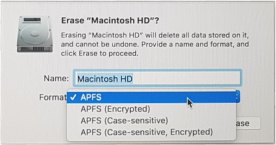Most users use Disk Utility to erase a disk or hard drive. But some Mac users might need to erase them from the command line on Mac OS. To do that, the only thing you need is a bit of precise syntax to make sure that you are erasing the proper disk.
How to Wipe a Mac Hard Disk Drive (HDD) NOTE: If you're interested in wiping an SSD, see below. Make sure your Mac is turned off. Press the power button. Immediately hold down the command and R keys. Wait until the Apple logo appears. Select 'Disk Utility' from the OS X Utilities list. So it is advisable to erase your hard drive to reduce the risks. How to Securely Erase Data from Your Mac and External Drives? Como abrir library en mac. You can use Disk Utility to securely erase hard drive in mac or an external hard drive. All you have to do is follow the steps given below: 1.Wiping your hard drive will erase everything.
Restart Your Mac. First, restart your computer. The most straightforward way is to hold down the. Dec 03, 2020 Use Disk Utility to erase your disk From the utilities window in macOS Recovery, select Disk Utility and click Continue. Select Macintosh HD in the sidebar of Disk Utility. Don't see Macintosh HD? Click on the Disk Utility option from the 'OS X Utilities' window. In the left pane of the Disk Utility window, click on Macintosh HD (which is your laptop's internal hard drive). In the right pane of the Disk Utility window, click the Erase tab. Click the OK button. Kensington usb 3 0 docking station mac. Click the Erase button. You'll be asked if you're sure you want to.
Here I'll show you how you can erase and format a disk using the command line.
Working with TerminalStart off by running the following command in the command line: Diskutil list
This is going to list all the mounted drives on your Mac.
Once you have found the proper drive to erase, just copy its identifier so you can use it for the next command. Then pick a name and a system format type. This is the syntax we need: Diskutil eraseDisk FILESYSTEM DISKNAME DISKIDENTIFIER
Let's say the disk I want to erase has '/dev/disk5s2' as its identifier and I'm going to use Mac OS Extended Journaled (JHFS+) as the system format type and name it 'Empty'. The syntax is going to look like this: Diskutil eraseDisk JHFS+ Empty /dev/disk5s2
It's important to keep in mind that if you run the eraseDisk command, the target disk is going to lose all its data, so make sure you are erasing the proper disk.
If you need different system format types, here are a few references you could use instead of JHFS+:
- Mac OS Extended: HFS+
- MS-DOS fat32: FAT32
- ExFAT: ExFAT
I don't know exactly which model you have, but you can do a Network Restore provided your model is from Late-2011 or later. Below are the steps to reinstall a clean copy of OS X after erasing the disk. However, before you do this you could just try repairing the disk.
Clean Install of Sierra or El Capitan on a Clean Disk
- Restart the computer. Immediately after the chime hold down the Command-Option-Rkeys until a globe appears.
- The Utility Menu will appear in from 5-20 minutes. Be patient.
- Select Disk Utility and click on the Continue button.
- When Disk Utility loads select the drive (usually, the out-dented entry) from the side list.
- Click on the Erase tab in Disk Utility's main window. A panel will drop down.
- Set the partition scheme to GUID.
- Set the Format type to Mac OS Extended (Journaled.)
- Click on the Apply button, then click on the Done button when it activates.
- Quit Disk Utility and return to the Utility Menu.
- Select Reinstall OS X and click on the Continue button.
How To Wipe Mac Hard Drive

This should install the version of OS X that was pre-installed when the computer was new.

This should install the version of OS X that was pre-installed when the computer was new.
Repair the Drive for Sierra and El Capitan
Erase Hard Disk Free Download
- Restart the computer and after the chime hold down the Command and R keys until the Utility Menu appears.
- Select Disk Utility and press the Continue button.
- Then select the indented (usually, Macintosh HD) volume entry from the side list.
- Click on the First Aid tab in the toolbar and wait for the Done button to activate. Click on it, then quit Disk Utility.
- Select Restart from the Apple menu.

